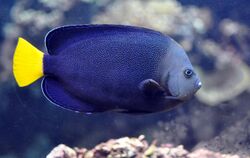Biology:Chaetodontoplus caeruleopunctatus
| Chaetodontoplus caeruleopunctatus | |
|---|---|

| |
| Scientific classification | |
| Domain: | Eukaryota |
| Kingdom: | Animalia |
| Phylum: | Chordata |
| Class: | Actinopterygii |
| Order: | Perciformes |
| Family: | Pomacanthidae |
| Genus: | Chaetodontoplus |
| Species: | C. caeruleopunctatus
|
| Binomial name | |
| Chaetodontoplus caeruleopunctatus Yasuda & Tominaga, 1976
| |
Chaetodontoplus caeruleopunctatus, the bluespotted angelfish, is a species of marine ray-finned fish, a marine angelfish belonging to the family Pomacanthidae. It is from the Western-Pacific Ocean.
Description
Chaetodontoplus caeruleopunctatus has a pale orange-brown head and anterior part of the body, while the remainder of the body is dusky brown to bluish-black marked with dense blue spots. The dorsal and anal fins are dark brown with blue margins, while the caudal fin is vivid yellow.[2] The juveniles are dark brown, pearl black with a yellow stripe on the forward part of the back and another on the head and around the dorsal fin, their tail is yellow and white.[3] The dorsal fin contains 13 spines and 17 soft rays while the anal fin has 3 spines and 17 soft rays. This species attains a maximum total length of 20 centimetres (7.9 in).[4]
Distribution
Chaetodontoplus caeruleopunctatus is endemic to the Philippines where it is rarely recorded in the wild.[5]
Habitat and biology
Chaetodontoplus caeruleopunctatus is found at depths between 14 and 40 metres (46 and 131 ft).[4] It prefers rock areas with a rich growth of sponges and algae.[5] Its diet is composed of sponges and tunicates.[4] Like all other angelfish it is a protogynous hermaphrodite, with all individuals being female initially and the dominant ones changing to males.[3]
Systematics
Chaetodontoplus caeruleopunctatus was first formally described in 1976 by the Japanese ichthyologists Fujio Yasuda and Yoshiaki Tominaga with the type locality given as the Philippines.[6] The position of this species is indeterminate and its closest relatives have not yet been resolved. It was proposed that it was a hybrid but the consistency of appearance of specimens collected and their numbers strongly suggest it is a valid species.[5]
Utlisation
Chaetodontoplus caeruleopunctatus despite its apparent rarity in the wild is quite frequently found in the aquarium trade and has been bred in captivity.[3]
References
- ↑ Allen, G.R. (2010). "Chaetodontoplus caeruleopunctatus". IUCN Red List of Threatened Species 2010: e.T165894A6159417. doi:10.2305/IUCN.UK.2010-4.RLTS.T165894A6159417.en. https://www.iucnredlist.org/species/165894/6159417. Retrieved 19 November 2021.
- ↑ "Chaetodontoplus caeruleopunctatus". Saltcorner!. Bob Goemans. 2012. http://www.saltcorner.com/AquariumLibrary/browsespecies.php?CritterID=74.
- ↑ 3.0 3.1 3.2 "Chaetodontoplus Caeruleopunctatus". De Jong Marine Life. https://shop.dejongmarinelife.nl/chaetodontoplus-caeruleopunctatus-pc-cae-001361-group.
- ↑ 4.0 4.1 4.2 Froese, Rainer and Pauly, Daniel, eds. (2019). "Chaetodontoplus caeruleopunctatus" in FishBase. December 2019 version.
- ↑ 5.0 5.1 5.2 Joe Rowlett (2017). "Huxley’s Line & The Bluespotted Angelfish". https://reefs.com/2017/01/30/huxleys-line-bluespotted-angelfish/.
- ↑ Eschmeyer, William N.; Fricke, Ron; van der Laan, Richard, eds. "Species in the genus Centropyge". California Academy of Sciences. http://researcharchive.calacademy.org/research/ichthyology/catalog/fishcatget.asp?tbl=species&genus=Centropyge.
- Froese, Rainer and Pauly, Daniel, eds. (2008). "Chaetodontoplus caeruleopunctatus" in FishBase. December 2008 version.
- Pete education:: https://web.archive.org/web/20120310055708/http://www.peteducation.com/article.cfm?c=16+1879&aid=2057
Wikidata ☰ Q2208824 entry
 |


